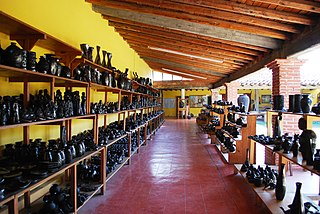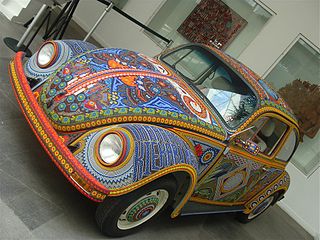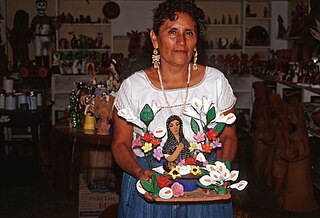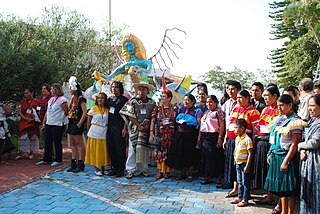Related Research Articles

Alebrijes are brightly colored Mexican folk art sculptures of fantastical (fantasy/mythical) creatures. The first alebrijes, along with invention of the term, originated with Mexico City cartonero Pedro Linares. Linares often told that in 1936, he fell very ill, and while he was in bed, unconscious, he dreamt of a strange place resembling a forest. There, he saw trees, animals, rocks, clouds that suddenly turned into something strange, some kind of animals, but, unknown animals. He saw a donkey with butterfly wings, a rooster with bull horns, a lion with an eagle head, and all of them were shouting one word, "Alebrijes! Alebrijesǃ Alebrijes!" Before this happened, he was already a cartonero artisan. Upon recovery, he began recreating the creatures he saw in Cartonería, the making of three-dimensional sculptures with different types of papers, strips of papers and engrudo

Barro negro pottery is a style of pottery from Oaxaca, Mexico, distinguished by its color, sheen and unique designs. Oaxaca is one of few Mexican states which is characterized by the continuance of its ancestral crafts, which are still used in everyday life. Barro negro is one of several pottery traditions in the state, which also include the glazed green pieces of Santa María Atzompa; however, barro negro is one of the best known and most identified with the state. It is also one of the most popular and appreciated styles of pottery in Mexico. The origins of this pottery style extends as far back as the Monte Alban period and for almost all of this pottery's history, had been available only in a grayish matte finish. In the 1950s, a potter named Doña Rosa devised a way to put a black metallic like sheen onto the pottery by polishing it before firing. This look has made the pottery far more popular. From the 1980s to the present, an artisan named Carlomagno Pedro Martínez has promoted items made this way with barro negro sculptures which have been exhibited in a number of countries.
Rodolfo Nieto Labastida was a Mexican painter of the Oaxacan School.

San Bartolo Coyotepec is a town and municipality located in the center of the Mexican state of Oaxaca. It is in the Centro District of the Valles Centrales region about fifteen km south of the capital of Oaxaca.

The Museo de Arte Popular is a museum in Mexico City, Mexico that promotes and preserves part of the Mexican handcrafts and folk art. Located in the historic center of Mexico City in an old fire house, the museum has a collection which includes textiles, pottery, glass, piñatas, alebrijes, furniture and much more. However, the museum is best known as the sponsor of the yearly, Noche de Alebrijes parade in which the fantastical creatures are constructed on a monumental scale and then paraded from the main plaza or Zocalo to the Angel of Independence monument, competing for prizes.

The Vochol is a Volkswagen (VW) Beetle that has been decorated with traditional Huichol (Wirrárika) beadwork from the center-west of Mexico. The name created by José Jaime Volochinsky is a combination of “vocho”, a popular term for VW Beetles in Mexico, and “Huichol”, the common name of the Wirrárika indigenous group. The project was sponsored by agencies associated with the Museo de Arte Popular, Mexico City, the states of Jalisco and Nayarit and other public and private organizations. The Volkswagen was covered in 2,277,000 beads applied by eight artisans from two Huichol families in an exclusive design based on Huichol culture.

The Museo Estatal de Arte Popular de Oaxaca or MEAPO is a small museum in the municipality of San Bartolo Coyotepec just south of the city of Oaxaca in Mexico. It is run by the state of Oaxaca to showcase the entity's handcrafts and folk art tradition, through its permanent collection, online “cyber-museum,” collaboration with national and international entities, and sponsorship of events such as craft markets, conferences, and temporary exhibitions. It is dedicated to the crafts and to the artisans and the cultures behind the items. Its collection contains samples of most of the crafts produced in the state, especially the Central Valleys region, but most of its collection consists of barro negro pottery, the specialty of San Bartolo Coyotepec. It is run by director Carlomagno Pedro Martínez, a recognized artisan and artist in barro negro.

Museo Universitario de Artes Populares María Teresa Pomar is a museum dedicated to Mexico's handcrafts and folk art tradition, called “artesanía.” It is part of the University of Colima in the city of Colima, founded by artesanía collector and promoter María Terea Pomar. It contains one of the most important collections of its type in Mexico, covering traditions from around the country as well as the artesanía and traditions of the state of Colima.

Carlomagno Pedro Martínez is a Mexican artist and artisan in “barro negro” ceramics from San Bartolo Coyotepec, in the Mexican state of Oaxaca. He comes from a family of potters in a town noted for the craft. He began molding figures as a child and received artistic training when he was 18. His work has been exhibited in Mexico, the U.S. and Europe and he has been recognized as an artist as well as an artisan. Today, he is also the director of the Museo Estatal de Arte Popular de Oaxaca (MEAPO) in his hometown. In 2014, Martínez was awarded Mexico's National Prize for Arts and Sciences

Traditional metal working in Mexico dates from the Mesoamerican period with metals such as gold, silver and copper. Other metals were mined and worked starting in the colonial period. The working of gold and silver, especially for jewelry, initially declined after the Spanish conquest of the Aztec Empire. However, during the colonial period, the working of metals rose again and took on much of the character traditional goods still have. Today, important metal products include those from silver, gold, copper, iron, tin and more made into jewelry, household objects, furniture, pots, decorative objects, toys and more. Important metal working centers include Taxco for silver, Santa Clara del Cobre for copper, Celaya for tin and Zacatecas for wrought iron.

The Aguilar family of Ocotlán de Morelos are from a rural town in the state of Oaxaca, Mexico. This town produced only utilitarian items until Isaura Alcantara Diaz began creating decorative figures with her husband Jesus Aguila Revilla. The couple taught their five daughters who continued innovating their own styles and then teaching the two generations after them. Two of the sisters, Guilliermina and Irene have been named “grand masters” by the Fomento Cultural Banamex, for their figures and sets of figures related to the life and traditions of Oaxaca, as well as Mexican icons such as Frida Kahlo and the Virgin of Guadalupe. The younger generations have made their own adaptations with some attaining their own recognition such as Lorenzo Demetrio García Aguilar and Jose Francisco Garcia Vazquez.

The Blanco family of Santa María Atzompa, Oaxaca, Mexico is noted for their ceramic production, especially decorative pieces. Their fame began with Teodora Blanco, who as a young child added decorative elements to the more utilitarian wares made by her parents. Eventually her work became noted by a foreigner who not only bought her entire production, also encouraged her to create new forms, leading to mostly human figures called “muñecas”. Her form of decoration, called “pastillaje,” was also an innovation for the area’s pottery and consists of small pieces of clay added onto the main surfaces, often covering much of the area. Teodora taught her children and although she intended that only the oldest daughter carry on her work, today three generations of the family continues making mostly decorative pottery, mostly following her work. These include Irma García Blanco, who have been recognized by the Fomento Cultural Banamex and Fernando Félix Pegüero García, who has won prizes from the Friends of Oaxacan Folk Art in New York and Premio Nacional de Cerámica in Tlaquepaque, Jalisco.
José García Antonio is a Mexican potter from San Antonio Castillo Velasco in the municipality of Ocotlán, Oaxaca, a town noted for its handcrafts. He still has is house and workshop there, located beyond the church behind a tall gate that hides what is inside.

Manuel Jiménez Ramírez was a Mexican carver, sculptor and painter credited as the originator of the Oaxacan version of “alebrijes,” animal creatures carved in wood and painted in strong contrasting colors with intricate designs. He was a charismatic and philosophical person, who believed he was the reincarnation of an artist. He began making animal figures of clay when he was a child but changed to wood carving later, creating human figures, nativity scenes, masks and more as well as the alebrijes. He work can be found in public and private collections in various parts of the world, especially in the United States.

Agustín Cruz Tinoco is an artisan from San Agustín de las Juntas, Oaxaca, Mexico noted for his wood carvings. His work has been recognized both in Mexico and abroad.

Oaxaca handcrafts and folk art is one of Mexico's important regional traditions of its kind, distinguished by both its overall quality and variety. Producing goods for trade has been an important economic activity in the state, especially in the Central Valleys region since the pre-Hispanic era which the area laid on the trade route between central Mexico and Central America. In the colonial period, the Spanish introduced new raw materials, new techniques and products but the rise of industrially produced products lowered the demand for most handcrafts by the early 20th century. The introduction of highways in the middle part of the century brought tourism to the region and with it a new market for traditional handcrafts. Today, the state boasts the largest number of working artisans in Mexico, producing a wide range of products that continue to grow and evolve to meet changing tastes in the market.

Jacobo Angeles is a Mexican artisan from San Martín Tilcajete, Oaxaca who is known for his hand carved and distinctly painted alebrije figures. The town is noted for its production of these figures which generally are carvings of animals painted in bright colors and bold designs, and Angeles grew up carving the local wood they are made from. The artisan’s work has become distinguished for the painting of fine, intricate designs over the base paint, often inspired by Zapotec and other indigenous designs. He works with his wife María del Carmen Mendoza, at the couple’s home and workshop in their hometown. While Angeles continues to create alebrijes, much of the production of the workshop is done by younger members of the Angeles family, which is a tourist attraction in the town. Angeles travels frequently to promote alebrijes and Zapotec culture, especially in the United States, and his work has been shown in major venues in Mexico and abroad, as well as featured in two books. In 2014, he was invited to the Vatican to meet Pope Francis and set alebrije nativity scenes and Christmas tree ornaments.

Marta Turok is a Mexican applied anthropologist focusing on socio-economic development, and one of the foremost schools on Mexican folk art. Through research, government work, education and advocacy, she has worked to raise the prestige of Mexican handcrafts and folk art and to help artisans improve their economic status. Her work has been recognized with awards from various governmental and non-governmental agencies.

Feria Maestros del Arte is a non profit organization and annual three-day event held to support Mexican handcrafts and folk art in Chapala, Jalisco, Mexico. Unlike other fairs of this type, invited participants are not charged booth fees or percentages, and are even afforded transport and accommodations with area families. The Feria has grown from thirteen artisan participants to over eighty, and the organization is legally recognized in Mexico and the United States.
References
- 1 2 "History". New York: Friends of Oaxacan Folk Art. Archived from the original on September 26, 2014. Retrieved May 24, 2014.
- ↑ "Exhibirán trabajos ganadores del concurso FOFA para jóvenes artesanos". NOTIMEX. Mexico City. November 4, 2013.
| Wikimedia Commons has media related to Friends of Oaxacan Folk Art . |